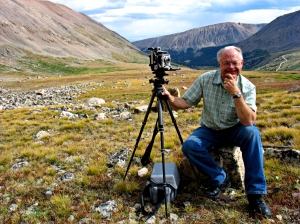
Rand at Mosquito Pass
This a blog about fine art photography with vintage cameras. So why am I still talking about digital? Because digital helps me think. And, although “artistic process” is a hackneyed term, artistic composition is just that- a process. And it can’t be hurried. As a result, my little digital camera often helps me to work my way through the maze of images that might somewhere hold a great picture.
This week, we visited our two children, Justin and Shannon, and their families in Denver, and of course I packed my four favorite cameras and a bag of film with me. Shannon and Pete, her wonderful and steadfast husband and companion, took me for a day in the high country in their off-road modified Jeep. We set out early in the morning, and the Jeep was soon clawing its way up boulder-strewn tracks amidst twisted pines and fields of Indian Paintbrush and alpine anemomes. After nosing down a seemingly impossible slope into a rushing creek, the Jeep clambered up the bank and deposited us in front of a wonderful abandoned turn-of-the century mining camp.

The Mine at Mosquito Pass
The main building was a fascinating, dilapidated complex of weathered siding, collapsing floors, graying vertical beams, and vistas of encircling jagged peaks seen through gaping window frames. It was a truly amazing subject– and totally overwhelming.
It is at times like this that I have the fantasy of a truly great photographer like Galen Rowell or Henri Cartier-Bresson walking in and snapping images that float directly onto the pages of Life or Aperture, while I wander aimlessly, totally unable to make any sense out of this visual cacophony. I hope that I am wrong, and I hope that the great ones also struggled to extract succinct and definitive images from the world’s disorder.
I wandered through the ruins, framing image after image on the screen of my little Canon digital point-and-shoot, and gradually a few patterns began to emerge. The collapsed wall siding of the overseer’s house formed a swirl of faded boards around a window framing trees and alpine meadow. An enormous, eroded pulley lay amidst a welter of beams and boards scattered like matchsticks across the hillside.

The Window
We needed to cross the pass before dark, so before I had time to set up my Baby Graphic, it was time to leave. The Jeep climbed higher into an alpine bowl surrounded by a ring of jagged ridges and crags like knife edges thrusting into the sky. The meadow was scattered with the detritus of old mining operations- the roof of a collapsed cabin, pieces of wood, and a cable that ran from a ring at my feet up the side of a nearby crag. Nearby, a field of rocks spilled across a flower-strewn meadow. Once again, the images were scattered and fragmented. What could I see that had line, form and color that would flow across a page and carry the eye with it?
Again, it was only with time that the images and the landscape began to soak into me. As I sat on a rock munching my egg and olive sandwiches (a Barrett family favorite) my mind began to slow and absorb the vista around me. I noticed the rocky track curving back down the valley and leading my eye up and over the pass behind the mine. I saw the afternoon sun briefly painting a craggy peak near the end of the valley. I snapped a few quick images– nothing to show to a gallery, but enough to remind me of the elements of the scene.
It was soon time to leave once again, and I still hadn’t opened my Baby Graphic– but I had a sense of the valley. And I knew that when I returned next year, it all might come together for me through my lens. I took away some snapshots, and I will mull over these and my memories of the valley. The lesson is to try to keep from getting frustrated when great images fail to come together. Sometimes even the most spectacular and unique setting lacks the lines and shapes that will flow through your lens onto an 8×10 sheet of photographic paper, and sometimes the elements of the most dynamic and striking image just need to wait until you can calm your mind and be ready to receive them.